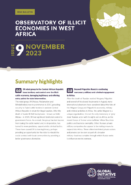Posted on 15 Sep 2020
The effects of the health crisis are changing every aspect of global society and trade. The demand and supply of many product categories, as well as their means of production and distribution, have been particularly impacted. We look at changes in the dynamics of demand and supply, the benefits of nearshoring to protect supply chains, as well as considering the impact of the pandemic on e-commerce and how new technologies can be used to combat counterfeiting.
Crises often present new opportunities for organized-crime groups, and this one is no different. Around the world, groups involved in counterfeiting have sought to capitalize on the new demand for virus-mitigating products, such as face masks, virus test kits, personal protective equipment worn by frontline workers and medical supplies used for treating COVID-19 patients. International organizations have connected these markets with dramatic increases in fake pharmaceuticals and medicines, adding to an illicit industry already estimated to be worth more than €4 billion. The pandemic has also increased demand for counterfeit personal protective equipment. In June 2020, for instance, 3M launched lawsuits against vendors of counterfeit versions of its N95 mask.
Although the counterfeiting of some high-demand products has increased significantly, the manufacturing of counterfeits was, unsurprisingly, at a near standstill while China was under quarantine. As manufacturing of goods resumes, we should expect the production of counterfeits to follow the same pattern. However, as consumer behaviour will be affected by the pandemic (for many, a reduction in household income is one key factor), the type of products that are targeted for counterfeiting could change dramatically.
In the case of most goods, producing counterfeits that are visually identical to originals is a relatively straightforward process. Packaging, branding and passable imitations of legitimate products can be quickly manufactured, and the counterfeiting industry has demonstrated that it is adept at reacting to changes in branding attempted by legitimate vendors.
The main challenge for counterfeiters is infiltrating legitimate supply chains, as inserting fakes into global supply chains is crucial to how organized-crime groups sell their products and maximize their profits. The fight against all counterfeit products, medical or otherwise, centres on protecting well-regulated and controlled supply chains.
The impact of nearshoring on counterfeit products
Strategies to contain the spread of the virus have disrupted global supply chains. This has created obstacles for legitimate and counterfeit traders alike. As European and North American businesses in the formal sector were confronted with sourcing problems as factories in China shut down, so too were organized-crime groups, which overwhelmingly source their fakes from China. Although this blow to the counterfeiting business is likely to be short term, with production resuming as supply chains normalize, a more long-lasting challenge to counterfeiting, particularly that based out of or reliant on China, could arise in the form of nearshoring.
Coronavirus-related disruptions to global supply chains add to a pre-existing climate of protectionism and declining globalization of trade. Securing sufficient supplies of simple yet vital products, such as face masks, has proved a challenge for Western countries, and this has led to a newfound awareness of how globalization and outsourcing have led Western nations to lose their ability to manufacture these products. In times of crisis, countries often act in their own interests, and traditional trading partners can no longer be relied on to provide supplies previously taken for granted. Hence the increasing dialogue about the weaknesses and vulnerabilities of complex global supply chains.
Nearshoring (also known as reshoring) is the practice of transferring production and manufacturing from an offshore base to a nearby or domestic location. This is increasingly appealing during the pandemic due to the prerogative of self-sufficiency. Although EU trade commissioner Phil Hogan recently made the case against it, there is mounting pressure in favour of shortening supply chains through nearshoring. In the fashion sector, for example, there is already evidence that the pandemic is making nearshoring attractive.
If nearshoring gains momentum among manufacturers, counterfeiters may suffer. Local supply chains are likely to be more secure and more easily regulated than complex offshore systems, as opportunities for infiltration are added with every extra step and middleman along the chain. For example, in the pharmaceutical sector, recent research from the OECD and EU shows that pharmaceutical supply chains are secure at the wholesale level, but become more vulnerable with the introduction of second-tier distributors. In Mexico, for instance, the Jalisco New Generation Cartel uses its control of small and medium-sized pharmacies to insert counterfeit products into the supply chain.
If the pandemic is therefore to have at least one positive effect, or side effect, on business and trade, it is that it may bring about a more challenging environment for counterfeiting by encouraging the advantages of nearshoring, where shortened supply chains lessen opportunities for counterfeiters to market their illicit products.
E-commerce: A developing battleground
If complicated supply chains involving large numbers of secondary distributors are vulnerable to infiltration of counterfeit products, then the e-commerce sector would seem to be the perfect environment for this to thrive. It is difficult to maintain a fake high-street impersonation of a real store but, online, masquerading has proved easy.
E-commerce platforms such as Amazon, E-bay and Alibaba rely on third-party vendors, and their websites actively seek to enable trade between them and customers to increase overall website traffic. Such platforms have become major facilitators of counterfeit trade due to minimal verification carried out on vendors.
The coronavirus pandemic has boosted growth of e-commerce as stay-at-home orders during lockdowns have driven consumers towards e-shopping. As of April 2020, US and Canadian online retail orders had grown by 146% against the previous year. This growth has been seen worldwide – even in places where e-commerce is less established. In Africa, which has the lowest levels of e-commerce trade globally, the online consumer sector has grown dramatically in recent months.
New opportunities for enhanced security
Although growth in e-commerce and an accelerated journey towards digitization may create opportunities for the infiltration of counterfeit goods in the short term, there are also reasons to be more optimistic in the long term. Though e-commerce platforms and techniques have facilitated illicit trade through weak security and verification procedures, there is evidence that online trade may soon become more difficult for counterfeiters to penetrate.
For a start, there is growing pressure from companies for e-commerce platforms to improve their security. Major brands such as Nike and Birkenstock have been critical of Amazon, citing unregulated third-party vendors and the abundance of fakes as major threats to their brands and business models. This pressure on the e-merchants from big brands appears to be having an effect. Amazon has pledged US$400 million in personnel and resources to improve brand registry and transparency by integrating new technologies.
This way, digitization and the growth of e-commerce are also creating opportunities to push back against the counterfeit market. This results from a new awareness of how technology may be used to improve global supply chains and from consumer good practice as digital knowledge and literacy develop.
From a public-health perspective, the pandemic has led to other changes in how connectivity is understood and interacted with. In China, for instance, the QR code has become one of the key technologies for fighting community virus transmission (and, some would say, for social control). QR codes are displayed on smartphones to verify citizens’ health status as they enter public places. Similarly, other coronavirus-tracking apps have been launched around the world. Though the effectiveness of many of these apps remains unknown, there is a new understanding of the ways in which technology can be used in tracking and tracing.
This growing awareness of how technology may be used to enhance security is also having an effect on global supply chains. Although existing uses of technology such as QR codes remain vulnerable to copying and counterfeiting, there are joint efforts to improve and further develop technological capacity to combat them. Possibilities for the secure digitization of physical products can be found in new technologies such as copy-detection patterns, while blockchain technology provides new opportunities for data sharing across the supply chain, which is crucial to support tracking and traceability.
While the current health crisis may have increased the opportunities for organized-crime groups to flood legitimate markets with counterfeit products in the short term, the long-term view is optimistic. The vulnerabilities presented by the crisis are likely to be temporary, and long-lasting measures, such as nearshoring and digitization, will open new avenues for enhanced security of supply chains.



